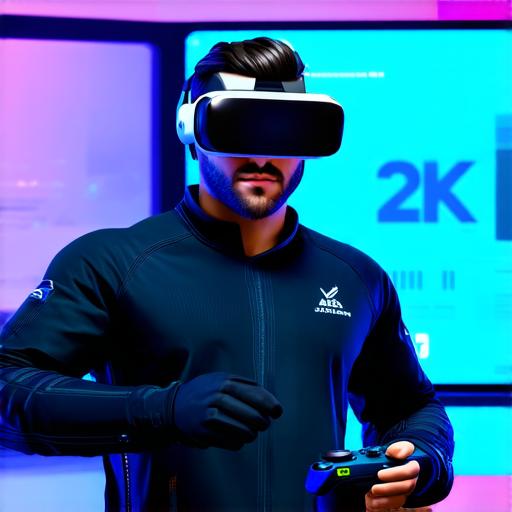Virtual reality (VR) is becoming increasingly popular in various industries, including gaming, education, healthcare, and more. It’s an immersive technology that allows users to experience a simulated environment, providing them with a sense of presence and interaction.
To create VR experiences, developers can use different tools and platforms, such as Oculus and Unreal Engine.
Understanding VR Development: The Basics
Before we dive into the specifics of using Oculus and Unreal Engine for VR development, it’s important to understand the basics of what goes into creating a VR experience.
Hardware Requirements:
To create a VR experience, you need a high-performance computer or gaming console, a VR headset, motion controllers, and other peripherals. Popular VR headsets include the Oculus Quest 2, HTC Vive, and PlayStation VR.
Software Tools:
There are several software tools available for creating VR experiences, such as Unreal Engine, Unity, and Blender. These tools provide developers with a range of features, including 3D modeling, animation, physics simulation, and more.
Content Creation:
Creating VR content involves designing the environment, characters, objects, and interactions that users will experience in the virtual world. This process requires creativity, attention to detail, and an understanding of user psychology and behavior.
Testing and Optimization:
Before releasing a VR experience, developers need to test it thoroughly to ensure that it runs smoothly and provides a positive user experience. They also need to optimize the content for different devices and platforms to ensure compatibility.
Leveraging Oculus and Unreal Engine for VR Development
Now that we have an understanding of the basics of VR development, let’s explore how developers can leverage Oculus and Unreal Engine to create engaging and immersive VR experiences.
Oculus:
Oculus is a popular VR platform that provides developers with a range of tools and resources for creating VR content. Some of the key features of Oculus include:
- Oculus SDK: This software development kit (SDK) provides developers with a set of tools and APIs for building VR applications on Oculus platforms. It includes support for various programming languages, such as C++, C, and Java.
- Unity Integration: Oculus supports Unity, a popular game engine that can be used to create VR experiences. Developers can use the Unity integration to leverage Unity’s features and tools, such as physics simulation, animation, and user interface design.
- Oculus Quest 2: The Oculus Quest 2 is a standalone VR headset that provides developers with a powerful platform for creating wireless VR experiences. It supports high-resolution displays, low latency, and advanced tracking technology.

Unreal Engine:
Unreal Engine is another popular game engine that can be used to create VR experiences. Some of the key features of Unreal Engine include:
- Blueprints Visual Scripting: This visual scripting tool allows developers to create complex logic and behavior without writing code. It’s particularly useful for creating interactive and immersive VR experiences.
- Physics Simulation: Unreal Engine provides advanced physics simulation capabilities that allow developers to create realistic and believable virtual environments.
- Support for Multiple Platforms: Unreal Engine supports multiple platforms, including Oculus, HTC Vive, and PlayStation VR, making it a versatile tool for VR development.
Real-Life Examples of Successful VR Projects Using Oculus and Unreal Engine
Now that we’ve discussed the tools and features of Oculus and Unreal Engine let’s look at some real-life examples of successful VR projects that have used these platforms.
Beat Saber:
Beat Saber is a music rhythm game that uses VR to provide players with an immersive and interactive experience. It was developed by Beat Games using Unity and Oculus. The game has become incredibly popular, with millions of users worldwide.
Job Simulator:
Job Simulator is a VR simulation game that allows players to experience various jobs in a virtual environment. It was developed by Oculus and uses Unreal Engine as the underlying technology. The game has been well-received by critics and players alike.
Anatomomy:
Anatomy is a VR educational tool that allows medical students to explore the human body in a virtual environment. It was developed using Unreal Engine and supports multiple VR platforms, including Oculus. The tool has received positive feedback from educators and students alike.
Half-Life: Alyx:
Half-Life: Alyx is a VR game that was developed by Valve Corporation and uses Unreal Engine as the underlying technology. The game has received critical acclaim for its immersive and interactive experience, with many players praising the game’s graphics and gameplay.
Challenges and Opportunities in VR Development
While VR development offers many opportunities for creativity and innovation, it also presents some challenges that developers need to be aware of. Some of the key challenges include:
- Hardware Limitations: VR hardware can be expensive and may not be accessible to all users. Developers need to ensure that their VR experiences are compatible with different devices and platforms.
- Motion Sickness: Some users may experience motion sickness when using VR, which can negatively impact the user experience. Developers need to take steps to reduce the risk of motion sickness, such as providing a comfortable seating area and minimizing sudden movements.
- Development Time: Creating a VR experience can be a time-consuming process that requires specialized skills and expertise. Developers need to plan their projects carefully and allocate sufficient resources to ensure success.
Opportunities in VR development include:
1. New Markets: VR offers new opportunities for businesses and industries to reach new audiences and provide unique experiences. For example, VR can be used in education to provide immersive learning environments or in healthcare to provide patients with virtual therapy sessions.
2. Enhanced Creativity: VR provides developers with new tools and possibilities for creating innovative and engaging experiences. This can lead to new forms of storytelling, gameplay, and interactive experiences.
3. Growing Demand: As VR technology continues to advance and become more accessible, there is a growing demand for VR experiences across various industries. This presents an opportunity for developers to create content that resonates with users and meets their needs.
Summary
In conclusion, Oculus and Unreal Engine are powerful tools that can be used to create engaging and immersive VR experiences. By understanding the features and capabilities of these platforms, developers can leverage them to create innovative and unique experiences that captivate audiences across various industries. While there are challenges associated with VR development, the opportunities for creativity and innovation make it a compelling field for developers to explore.



